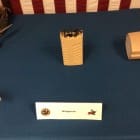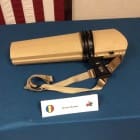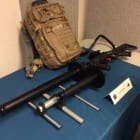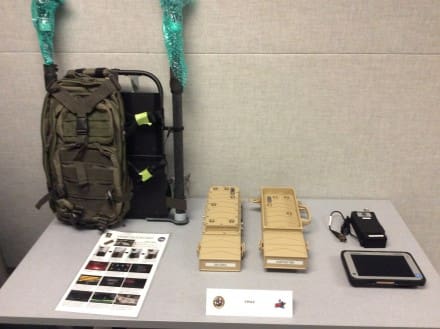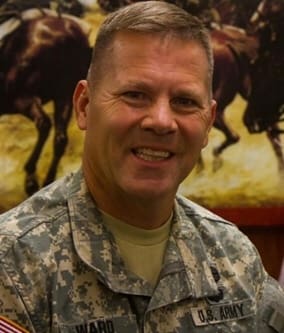 Although yesterday was Rapid Equipping Force Director, Colonel Lanier Ward’s last day on the job, he invited members of the defense press to visit the organization and learn about their latest activities.
Although yesterday was Rapid Equipping Force Director, Colonel Lanier Ward’s last day on the job, he invited members of the defense press to visit the organization and learn about their latest activities.
For those of you unfamiliar, this Army unit was stood up in 2002. The REF reports directly to the U.S. Army Training and Doctrine Command, providing rapid material solutions to Soldiers for urgent combat requirements by harnessing current and emerging technologies.
The organization has met challenges as diverse as improving force protection, providing ISR in austere locations, improving operational energy sources and enhancing communications. The REF maintains a forward presence in Iraq, Afghanistan and Kuwait and routinely coordinates with forces deployed globally.
COL Ward started out talking about the term “Rapid”. Lots of new organizations are being formed within DoD and are being referred to as “Rapid”. The REF has been doing it for quite some time now and seem to have the process down. However, COL Ward reminded us that although they work with all of the Army Service Component Commands, the REF’s focus is fairly narrow; specifically on small unit solutions. He related “we are about the now, and buy the Army time.”
Although they’ve downsized about one-third in recent years, the organization remains robust. It is currently 140 personnel including 30 military and 21 Department of the Army Civilians. The rest of the REF’s strength comes from a dedicated contractor force.
When asked how the REF differs from a PM shop, COL Ward replied “I’m an operator; I came in here without a clue how acquisition works. I look at everything through the prism of how Operations work.” He went on, “I’m more operationally focused, because I’m about the now.” While he might be a stranger to the Acquisition process, COL Ward and his predecessors understand Operations. Consequently, they’ve been given authority by the Army’s G3/5/7 to validate requirements from the field.
Unfortunately, with that Operations background comes some misperception from those outside the organization. One misunderstanding COL Ward wanted to address is that the REF is not strictly Commercial Off The Shelf (COTS) focused. Instead, they rely heavily upon Government Off The Shelf (GOTS), which they may employ in new ways, or are not yet ready for full fielding, due to funding. This tactic leverages money that’s already been spent, but also provides feedback on developmental systems, leading to improvements based on operational use. The reality is that the REF goes where the solutions are. They partner with Industry, Academia, and Government entities to provide innovative solutions to urgent needs.
One of the REF’s biggest successes is the Expeditionary Lab which offers design and limited production capability in a deployed environment. The ExLab is equipped with design software, 3D printers and other limited metal bending capability. A Soldier can show up at the ExLab, identify a problem, and the REF team designs and produces prototype solutions right there on site. Currently, one ExLab is operational in Afghanistan, while the other is mothballed in Kuwait. When asked why one was out of service, COL Ward replied, “It works best when it has the Soldier footprint around it.” Based on the situation in Iraq, they closed that one, at least for now.
The REF focuses on capability gaps. Any Soldier can submit a 10-liner, which is a message used to identify a capability gap. The REF follows up with the submitter’s chain of command to ensure the requirement is valid and not a case of a Soldier trying to get some shiny new kit he saw on SSD. The majority of 10-liners focus on Force Protection, Intelligence and Movement and Maneuver. Naturally, the vast majority originate from the CENTCOM AOR. Although they come from all levels of command, COL Ward said that he had denied a 10-liner from a Division commander. “I can’t fix all of the Army’s shortfalls.”
The REF’s military personnel include Outreach & Assessment NCOs. We met with three of them, SFC Rahamane Cisse, SFC Mark Walker Jr., and SSG Duryea Williams who walked is through several C-UAS and EW technologies. At home station, they conduct assessments of candidate technologies and in the field, they work with their deployed customers to provide required capabilities.
The REF uses Burnoff events to evaluate commercial capabilities for certain problem sets. “We see if your dog can hunt. If it can, maybe I’ve got a solution I can give to Soldiers,” stated COL Ward. Additionally, the REF provides the safety confirmation. In some cases, that safety confirmation will include cautions that the material must be used within certain parameters. That’s another reason they keep up with the capability for up to two years, to ensure information like that is passed from one deployed unit, to the next.
Counter-UAS is a major focus, answering Joint Urgent Operational Needs Statements from Iraq, to offer the best, readily available capabilities. However, these are interim steps, not final solutions. COL Ward doesn’t look at pieces of gear as his “items” the way a traditional PM would mentioning “we field, not equip.” Sometimes they have to remind industry. He said, “We’ve had to go back and spank companies on occasion,” after they’ve sold something to the REF and then advertised they are providing the Army’s solution.
The REF is linked in very tight with JIDO on the C-UAS front. COL Ward told us that they are good at looking at emerging capabilities, “We don’t do anything alone. We don’t have the capacity and I’d be fooling myself.”
While the UAS threat continues to evolve, the REF continues to work on solutions. For instance, their efforts have evolved from just dismounted small tactical units to providing input to support FOBs. The concept of “defense in depth” requires multiple capabilities to counter the various UAS threats. There isn’t just one UAS, meaning there must be multiple counters. They are also working with other agencies as part of a greater whole. For example, PM C-RAM is office of primary responsibility to support all of C-UAS for CENTCOM. Despite their extensive work, COL Ward sees an eventual end to the REF’s C-UAS efforts.
REF is also working with the Army’s Rapid Capabilities Office on the Electronic Warfare problem set. Their initial EW capability deliverable was a manpack system based on GOTS equipment such as C-IED equipment, with some system integration and capability enhancement. Not only does it offer an immediate capability, it also informs future requirements. They are now taking it one step further by increasing capability with the EW Tactical Vehicle capability which required additional, off-site system integration. They’ll hold a mobile EW event in March.
RCO looks at problems from one to five years out, while the REF is much closer, at zero to two years. In fact, REF’s goal is to put a capability into the Soldier’s hand within 180 days. Their two year window is because units rotate. The REF prepares units due to rotate so they can fall in on equipment they’ve already fielded.
Partnering with the Asymmetric Warfare Group, REF is also looking at a Subterranean capability which was most recently evaluated in Indiana. However, they initially went to nearby Quantico to work with the FBI, leveraging lessons learned from law enforcement. Specifically, they’ve evaluated command and control, breaching, power generation, and self-contained breathing apparatus. However, they haven’t fielded any equipment. Instead, they’ve got a menu of capabilities they can provide to the warfighter in the event they are needed.
They recently assisted in fielding equipment for 1st Security Force Assistance Brigade including comms and fire support. COL Ward expects to help this new unit out even more. For instance, they’ve been looking at a tethered ISR capability for use by SFAB and others. One solution is a tethered copter which answers the need for extended duration.
The REF isn’t going away. It is very relevant. The REF is a modular organization within TRADOC, working on Army problems. Focusing on the now, REF has become an enduring capability, unlike similar, ad-hoc organizations stood up during previous conflicts which were disbanded after a short period of time. In fact, COL Ward related that the REF is finally going to move out of the trailers they started in 16 years ago. As a permanent part of the Army, it’s about time they move to a permanent home.


